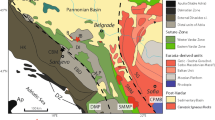Abstract
The Rammelsberg polymetallic massive sulphide deposit was the basis of mining activity for nearly 1000 y before finally closing in 1988. The deposit is hosted by Middle Devonian pelitic sediments in the Rhenohercynian terrane of the Variscan Orogen. The deposit consists of two main orebodies that have been intensely deformed. Deformation obscures the original depositional relationships, but the regional setting as well as the geochemistry and mineralogy of the mineralisation display many characteristics of the SHMS (sediment-hosted massive sulphide) class of ore deposits. Rammelsberg is briefly compared to the other massive sulphide deposits in the European Variscan, including Meggen and those deposits in the Iberian Pyrite Belt.
Similar content being viewed by others
Author information
Authors and Affiliations
Additional information
Received: 28 September 1998 / Accepted: 5 January 1999
Rights and permissions
About this article
Cite this article
Large, D., Walcher, E. The Rammelsberg massive sulphide Cu-Zn-Pb-Ba-Deposit, Germany: an example of sediment-hosted, massive sulphide mineralisation. Mineral. Deposita 34, 522–538 (1999). https://doi.org/10.1007/s001260050218
Issue Date:
DOI: https://doi.org/10.1007/s001260050218




